-
Posts
4,376 -
Joined
-
Last visited
Content Type
Profiles
Forums
Gallery
Events
Everything posted by Egilman
-

Honda RC166 Grand Prix Racer by CDW - FINISHED - Tamiya - 1/12
Egilman replied to CDW's topic in Non-ship/categorised builds
Yep it seemed to be a bit on the too fiddly side watching you try to get it right... WAY too much work... I think I would have ditched the idea of closing the clips and used Gators Grip to glue them on.... Probably stood a better chance of staying together that way.... Lesson learned I suppose, but one of many in our modeling careers though, the upper limit on photoetch.... -
You had to have a feel for it.... But you both knew when the ol' snorkel came up... {chuckle} (plenty of room to maneuver for the deep dive)
-

US 6” gun by RGL - FINISHED - Panzer Concepts
Egilman replied to RGL's topic in Non-ship/categorised builds
Good to see you back Dennis.... WE missed ya... -

US 6” gun by RGL - FINISHED - Panzer Concepts
Egilman replied to RGL's topic in Non-ship/categorised builds
Gorgeous... Well done sir... If I may make a suggestion, for historical accuracy, a properly organized Gun Train would have the command car in front, the Liberty "B" truck following that, then the gun sections and the repair truck following the gun.... The gun can be barrel first or carriage first doesn't matter, when they got to the site the tractors were detached and the gun crew man-handled the pieces into position for assembly... (if they didn't have a crane available) Brother, This is going to be absolutely spectacular!!!! -

Honda RC166 Grand Prix Racer by CDW - FINISHED - Tamiya - 1/12
Egilman replied to CDW's topic in Non-ship/categorised builds
You want the flat tipped ones, the pointy ones will not take the strain of trying to close the clips... That's why the jewelry set is the exact set for this type of work, the flats are for closing those miniature chain links in fine jewelry... There is another way of doing this, canopy glue... dries clear and reduces so it leaves no lumps, (ultra thin) and is designed for holding PE..... The chain isn't going to take a strain at all, and makes connecting it on the bike easy peasy... -
Actually it is poor design, but then it IS only a model mill... Proper procedure would be to cut the dovetail into the saddle on both sides from a one piece casting to ensure parallelism of the dovetails, then counterbore the access for the cross slide nut... the counterbore would not affect the dovetail slide's operation in anyway and the whole thing being one piece, would be twice as strong... An over simplification if you ask me... and many more opportunities to make mistakes given the number of extra machining operations.... But then again it is only a model, not intended for actual operation making parts...
-

US 6” gun by RGL - FINISHED - Panzer Concepts
Egilman replied to RGL's topic in Non-ship/categorised builds
The camo pattern is derived from the early '17 French three color camo as used on the FT'17's and Schnieders... Splotches of Green, Khaki and Brown separated by black stripes,,, it was deemed the most effective camo used... After the breakout from the trenches, it was agreed by the allies to use camo again, and they decided on Green, Khaki and an off white ivory color... Primarily it was hand applied and it shows on the black stripes used to separate the blotches... Those troops who had time generally did a better job of painting, those in action did a lot sloppier job of it... It was a green based camo pattern and green should dominate the pattern, (but a Khaki dominated pattern was not out of the question) The mud of the trenches gave way to a yellower dust as the drier summer & autumn months came around... Yes, even in eastern France... By the summer of '18 it was again a maneuver war, mud would be less prevalent and, dusty conditions would dominate... The model "T" staff car, could easily appear that way, a tad too Khaki for my taste, but very appropriate, and one of many possible looks if the troops that hand painted it were in a hurry and were looking to just get it done... This three color camo pattern was adopted as standard by the US Army and is seen on many preserved WWI pieces in museums, although by '20 they adopted a distinctive five color pattern as standard.... The paint job is great, nice application and completely period in my opinion... (entirely possible as well Brother) EG -
So this is a dragster version, a custom built car in it's own right... The engine is a 235 ci Blue Flame Special, Specially built for the Corvette's from '53 to '55 when coupled with the powerglide automatic transmission... it was one of the first high output engines... (for the early '50's that is) also one of the first muscle car engines... 150 hp @ 4200 rpm, 223 ftlb of torque at 2400 rpm.... It would burn any tire mounted to the 3.73 ratio posi-traction rear end... That was the car and engine that gave the powerglide transmission it's reputation in the drag strip community during the 1950's-'60's...
-
Not cheating, That 235ci Stovebolt 6 had to be custom fitted into a dropped chassis.. All the straight header pipes had to be "massaged" to fit without striking the ground... Fitting that it had to be duplicated on a model...
-
Most of the time they didn't... what is usually in the way of the windscreen? the gunsight... (usually right at eye level) Even in light commercial planes, the best view from the cockpit is the forward part of the side window... Yes, you can see out the front, but it definitely isn't the best view... the HUD was a revolution in visible, useable forward sightlines when it came out...
-

Grumman F7F-2N2 Tigercat by Javlin - AMT - 1/48 - PLASTIC
Egilman replied to Javlin's topic in Completed non-ship models
Back in the day when I built it, the landing gear were the main issue with it they kept breaking from the weight required to get it to sit on it's gear... I did it in NSB representing a plane off the Lexington... My resolution was to scratch the gear in metal.... Overall it was a pretty boring build, interesting aircraft just not enough to keep the interest going... Took two years to finally complete it... I wound up giving it to a friend who really liked it.... -

Honda RC166 Grand Prix Racer by CDW - FINISHED - Tamiya - 1/12
Egilman replied to CDW's topic in Non-ship/categorised builds
Yep, that what was in my brother's bike when he bought it, he replaced it with a speed shop custom crank, lighter and stronger... -

Honda RC166 Grand Prix Racer by CDW - FINISHED - Tamiya - 1/12
Egilman replied to CDW's topic in Non-ship/categorised builds
Probably a billet crank, relieved, shot peened and magnafluxed, as light as possible... Brother built a 250 cafe racer, everything you could conceive of went into it, it was quick when he bought it... When he was done, he hit it in a parking lot and promptly spun the rear tire off the rim... Had the tires bolted to the rims... He eventually learned to ride it, 0-135 in 8 seconds... Had it for two years then sold it cause he realized that he would eventually kill himself on it... It was perfect not a scratch or ding... The guy he sold it too promptly flipped it onto its back when trying to take off on it... It didn't need much throttle to take off... Man, those were the crazy days... -
A little comparison is in order... The c651... A little yellow shifted true, but still the only color pic I have been able to find of the actual aircraft.... US Navy Sea Blue - Non-Specular sea blue... F8F Bearcats... Mid 50's.... F4U Corsairs post Korean War.... This last one is also a bit yellow shifted... This is the closest match to the paint on the subject I can find... And the paint on the Corsair and Bearcat is high gloss.... I suspect the same for the Caudron c651 as well... Maybe an eighth of a shade off but that's your color...
About us
Modelshipworld - Advancing Ship Modeling through Research
SSL Secured
Your security is important for us so this Website is SSL-Secured
NRG Mailing Address
Nautical Research Guild
237 South Lincoln Street
Westmont IL, 60559-1917
Model Ship World ® and the MSW logo are Registered Trademarks, and belong to the Nautical Research Guild (United States Patent and Trademark Office: No. 6,929,264 & No. 6,929,274, registered Dec. 20, 2022)
Helpful Links
About the NRG
If you enjoy building ship models that are historically accurate as well as beautiful, then The Nautical Research Guild (NRG) is just right for you.
The Guild is a non-profit educational organization whose mission is to “Advance Ship Modeling Through Research”. We provide support to our members in their efforts to raise the quality of their model ships.
The Nautical Research Guild has published our world-renowned quarterly magazine, The Nautical Research Journal, since 1955. The pages of the Journal are full of articles by accomplished ship modelers who show you how they create those exquisite details on their models, and by maritime historians who show you the correct details to build. The Journal is available in both print and digital editions. Go to the NRG web site (www.thenrg.org) to download a complimentary digital copy of the Journal. The NRG also publishes plan sets, books and compilations of back issues of the Journal and the former Ships in Scale and Model Ship Builder magazines.








.jpg.ddec45c2cb691e5882d747e7c8152ee5.jpg)
